I’m currently an invited artist in Binary Inventions: Art and Culture in the Digital Age, in conjunction with a UND Art Department conference on the same subject. The show is at Third Street Gallery in Grand Forks – Oct 5 – 26, 2012.
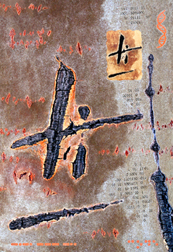 Arborglyphs: (1 symbol 30) Code, © 2012, Linda C Everson. The title Binary Inventions intrigued me. My digital print with solarplate – Arborglyph: (1 symbol 30) Code, contains hints of various codes; plus/minus as in my Arborglyph symbol, binary code (0110100), genetic code, Morse code, and Braille code. They are all forms of messaging or communication. Code is “a rule for converting a piece of information into another form or representation”.
A binary system involves only two choices: 0 or 1, yes or no, true or false, on or off switch in electronics, and plus or minus. Despite how simple this all sounds, very complicated things happen because of codes. For instance, it was recently discovered that the human genome has 4 million on/off switches that tell our genes what to do. Also, the use of the computer and the internet has changed our lives immensely in the last years. We can send messages globally in seconds. And we can record photographs and videos digitally instead of on film. In terms of size, the aspen clone, Pando, is believed to be the world’s most massive organism. The aspen’s form of reproduction is cloning (by genetic code). And aspen tree bark markings are the impetus for my Arborglyph images.
Code often lies below the surface where we can’t see it; as in computer language, electronic switches, or genetics. Code is found in nature and in man-made entities. It can be common knowledge or secret. Code is everywhere!
 BINARY CODE: Binary is a two-digit numerical system in which computers store data and compute functions. Computers use the binary system because digital switches inside the computer can only be set to ON or OFF, which are represented by 1 or 0. In computer science, a code is considered as an algorithm which uniquely represents symbols from a source alphabet by encoded strings. ASCII uses a 7 bit binary code to represent text within a computer… 0100101 0111010 BINARY CODE: Binary is a two-digit numerical system in which computers store data and compute functions. Computers use the binary system because digital switches inside the computer can only be set to ON or OFF, which are represented by 1 or 0. In computer science, a code is considered as an algorithm which uniquely represents symbols from a source alphabet by encoded strings. ASCII uses a 7 bit binary code to represent text within a computer… 0100101 0111010
 GENETIC CODE: The genetic code is based on sets of nucleoside base pairs called “codons”. Codons transcribe and translate genetic traits from DNA to RNA and RNA to proteins. New findings reveal that the human genome has 4 million + on/off switches that tell our genes what to do. GENETIC CODE: The genetic code is based on sets of nucleoside base pairs called “codons”. Codons transcribe and translate genetic traits from DNA to RNA and RNA to proteins. New findings reveal that the human genome has 4 million + on/off switches that tell our genes what to do.
 MORSE CODE: Morse Code transmits text by a series of on/off tones, lights, or clicks to commute a message. MORSE CODE: Morse Code transmits text by a series of on/off tones, lights, or clicks to commute a message.
 BRAILLE CODE: Braille is a binary encoding scheme that represents the characters of writing for the blind that is done in a series of 6 dots. BRAILLE CODE: Braille is a binary encoding scheme that represents the characters of writing for the blind that is done in a series of 6 dots.
A favorite mentor, Antoni Tapies, passed away on February 6, 2012 in Barcelona, Spain. Although Whitney Houston’s high profile death headlined all the US media at the time, his death was not well heralded here. However, Antoni Tapies was much more intriguing to me! I had visited his Tapies Fundacio several times in Barcelona. His art was both quiet and reflective, and also often large and forbidding. It too, could cause much emotion!
His use of graffitti and texture were elements that I admired and use in my own art. If you look at his artwork and at mine, your would probably not see many similarites, yet our visions were fairly similar. We both liked surface and texture, both made use of symbols and language in an abstract manner.
Please read my former blog about Antoni Tapies. I will cherish his memory and his art.
I just saw a great art show Triggered Momentum by Sabin Aell, a contemporary photographer, at Walker Gallery in Denver. The subject matter was quite unusual… BATH TOWELS! What also impressed me was her artist statement. Sabin had stepped outside and saw a “bizarrely shaped form: a towel”. The towel was frozen and had ice crystals on it; so she had a “you know it” moment … which is “triggered by objects you see”. Sabin immediately knew what was the subject matter for her next art series…. frozen towels.
The frozen towels took on a new form in her artwork. They danced and swayed in space, vaguely resembling many other things in the eyes of the viewer. This transformation of one odd object into something else was quite beautiful. It’s something I also try to do with my Arborglyphs monoprints. I see tree bark markings and they become something else. It’s what creativity is about… seeing and transforming. The objects you initially see become something else. Like magic!
I just saw the premier of the play Map of Heaven by Michele Lowe at DCPA in Denver. The story is about a rising female artist in New York and her busy physician husband. It isn’t so much a story about art, but instead focuses on relationships and maps, the path one’s life might be taking and how it can be changed irrevocably by an incident. In this story, several lives are sent on different paths after an ethical tragedy. Coincidentally, the artist’s paintings are MAPS! And the physician is a radiologist who looks at ‘maps’ of cellular tissue in mammograms. Except of course he messes up one very badly. Very clever and interesting interplay between the maps of 5 people’s lives. However, I don’t know if agree with one reviewer’s view that the theme was about:
the healing power of art.
In the last week, the chaos and protests that have taken place in Egypt have kept our eyes locked on the TV for more news. Recently looters had broken in the Egyptian museum, and luckily not much was ransacked, unlike the looting done in Iraq during the invasion.
I was in Egypt a few years ago and visited the Egyptian Museum, the pyramids, and other famous sites of anquities that are so valuable. One can only hope that Egypt, it’s people, and its famous sites will not be harmed too badly.
All eyes are on Egypt these days and although it is difficult, journalists are recording the events as they unfold. They hopefully have all-seeing eyes.
 Arbor-Hieroglyph: The Third Eye I. © 2007, Linda C. Everson This reminds me of the many eye hieroglyphics that I saw so often while there. I use aspen tree eye images in many of my Arborglyph monoprints, and recently began a new series which included tree eyes, hieroglyphics and of course The Eye of Horus, which is said to have protective and healing powers. Let’s hope that during these protests in Egypt, there will be a protective eye over everyone there.
Detail
I was just at the Boulder Museum of Contemporary Art admiring the Stephen Batura’s show Edits with his wonderful acrylic paintings that were based on his collages of fashion. However, its difficult to see the ‘fashion’ in his art because of the closeup views and chopped up angles. That’s what makes this artwork so interesting to me. Stephen Batura has
a focus on texture that extends beyond the given context.
The above quotation about his artwork resonates with my own intentions in my Arborglyphs artwork. Texture is the focus, NOT the representation of the original image. While Batura’s paintings seem quite abstract in a glance, upon much inspection you see elements of reality – the flow of drapery, the collar of a shirt, or a portion of a body part.
I also like the way Batura uses triangles and other sharp angles that seem to overlap and collide with each other. There is a sense of layering here. However Batura’s use of a typical rectangular canvas with the angled imagery centered on top of a bland background color was boring. I think the paintings would have been more effective if he had created ‘shaped’ canvases. I created many shaped paintings in the past, and found that makes for an interesting departure from the typical horizontal shape.
When visiting Israel I photographed several interesting artistic views. Art is everywhere and it inspires us all. All the different religious, cultural and historical factors mixed together create such fascinating imagery.
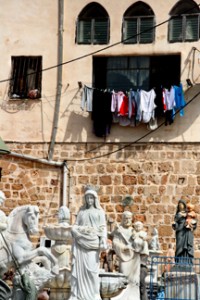 Acre sculptures and laundry
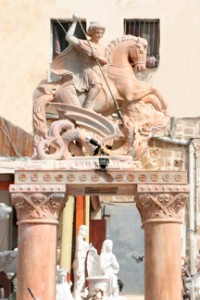 Acre more sculpture
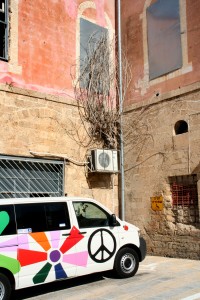 Old Jaffa van and vines 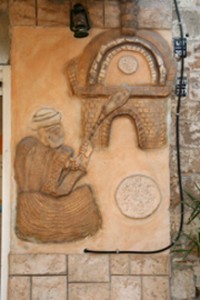 Acre bread oven 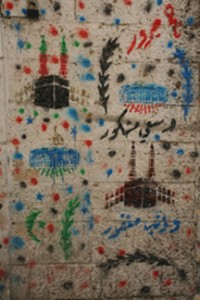 Old Jerusaleum art on wall 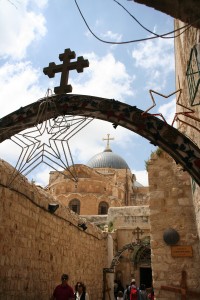 Old Jerusaleum crosses
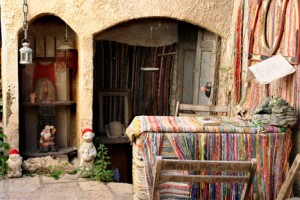 Old Jaffa entryway
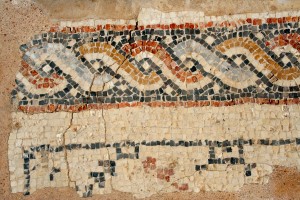 Mosaic
 Old Jerusaleum religious icons
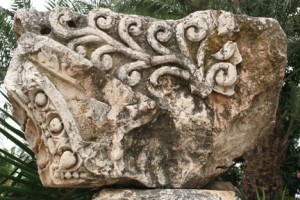 Roman capital in Caesarea 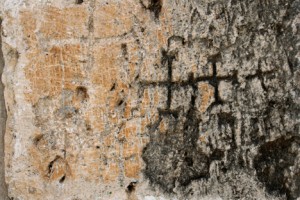 Old Jerusaleum African cross graffiti
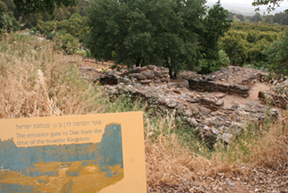 Tell Dan I visited Israel recently and saw layer upon layer of many different civilizations and religions that inhabited the land. While there I explored Tell Dan in northern Israel and also climbed the tell at Beit She’an to view the excavations below. Archaeology has always been interesting to me.
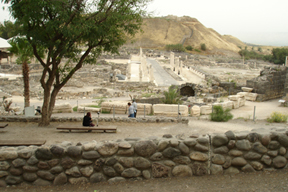 Beit She'an with tell in background A perfect accompaniment on the trip was The Source by James Michener. It’s a fictitious historical novel about Tell Makor in northern Israel, where archaeologists dig through multiple layers of the tell or mound and uncover 10,000 years of civilization. Each layer in the tell unearths artifacts from a previous period in time, and the story then reverts back to that time.
What is particularly interesting in The Source is the evolution of religion and “god”. It starts with Stone Age man and the first glimpses of spirituality; then proceeds with the fertility goddess Astarte and the fertility god/s Baal, describing in detail the various sacrifices and monoliths. The Cananite deity El eventually evolved into El Shaddai, and then into Yahweh (YHWH), the Hebrew god of Moses and possibly his ancestors. Monotheism (one god) starkly contrasted with the polytheistic (multiple gods) of the Greeks and Romans in later years.
One of my Arborglyph monoprints is called All Seeing Yahweh. For many Jewish people, the name Yahweh should never be spoken. Therefore, the Tetragrammaton or four letters YHWH often replaces the name Yahweh. However it’s possible that:
Hebrew scripts write it as four consonants, rendered in Roman letters as YHWH, due to the fact that most alphabets, prior the Greek alphabet, did not display vowels, and required that vowels be mentally pronounced in the proper places.
And although the name Yahweh should not be spoken, the Jewish Encyclopedia states that The Old Testament had 6,823 references to Yahweh.
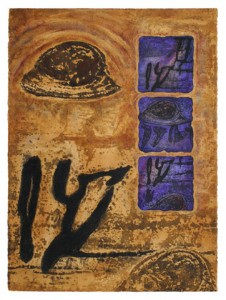 Arborglyph: (1 symbol IY) All Seeing Yahweh © 2005. Linda C. Everson. All rights reserved. Yahweh was a strong, demanding ‘god’ to the Hebrews. The meaning of the word Yahweh has been interpreted as “to be”, or according to WordIQ many scholars believe it means “He Brings into Existence Whatever Exists”. This coincides with a timelessness about ‘gods’ existence. Which gets back to the novel The Source and its prevailing theme of many gods and religions throughout the centuries in Israel.
My Arborglyph monoprint, All Seeing Yahweh has several images with an IY symbol and also contains several ‘tree eyes’; hence the All Seeing title. The “all-seeing eye” has been associated with several other religions or cultures… The “Eye of Horus” in Egypt, the “Eye of the World” in Buddhism and the Christian Trinity.
The “all-seeing eye of God” is also analagous to the “Eye of Providence” which generally depicts an eye that is sometimes surrounded by a triangle. This “Eye of Providence” is on the Great Seal of the United States and is also a Free Masonry symbol. The eye icon is a powerful image in many cultures and in countless artworks.
I recently visited Israel. In only 5 days time, I saw Caesarea, Acre/Akko, Nazareth, Tel Dan in the Golan Heights, Capernaum and the Sea of Galilee, Beit She’an, the Dead Sea, the Caves of Qumran, Massada, and numerous sites in Jerusaleum. I saw layers upon layers of civilization, and heard the countless stories of various cultures and religions that have inhabited the area. It was an amazing experience!
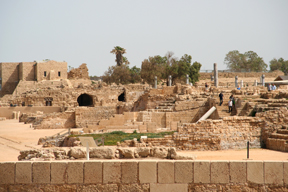 Caesarea On the coast I visited the port city of Caesarea, where the great Roman architect Herod built 2 harbors, an aqueduct, a Roman amphitheatre, marvelous temples and markets in 30 BCE.
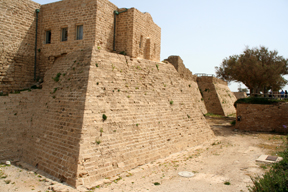 Crusaders Castle Layers of other cultures and invaders show in the remnants of a Crusaders Castle (1101 – 1265) in Caesarea.
In the Old City of Acre I saw the Citadel and then went underground into the “belly”of the Crusader city where I experienced the Knights Halls with it’s monsterous pillars, arches, crypts, and the Templar’s Tunnel. Above ground (or above our heads) stands the Muslim quarter and markets with Khan El Qmdan.
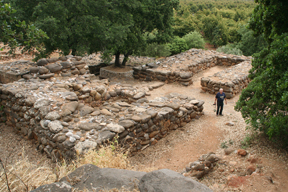 Tell Dan 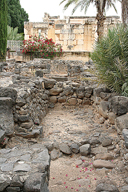 Capernaum In the Golan Heights, I visited the headwaters of the River Jordan, Tell Dan, and Capernaum where Jesus and Peter lived. Everywhere you saw rocks and more rocks, layers and more layers. Several years ago I did a series of monoprints called Natural Abstractions, and rocks and layers were the major theme.
Nearby in Beit She’an (where only 1/10th of the 400 acre site has been excavated) I marveled as I walked through the Hellenistic and Romanesque baths, pillars, and temples. In the background was a another huge tell (first inhabited in fifth milllennium BCE) with more layers of history to be uncovered, so we naturally climbed the tell to get a better look from above. Looking back at the excavation we could see the signs of a modern industrial city on the top layer.
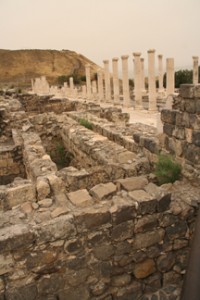 Beit She'an with tell in background 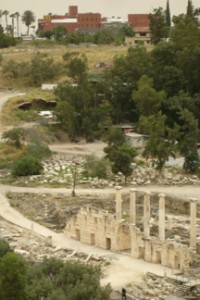 Beit She'an below, modern industry above 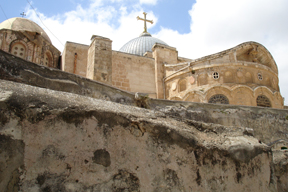 Wall and church above in Jerusaleum Old Jerusaleum with its four ancient quarters again reiterated the theme of layers. Its impossible to explain in a blog all the buildings throughout history that were built and destroyed, rebuilt and destroyed, in Jerusaleum. One religion ontop of another, anywhere you went. For example, the Church of the Holy Sepulchre was built over the site of a temple of Aphrodite. And the infamous Muslim Dome of the Rock sits ontop of the Temple Mount, which was the site of the Second Temple of the Jews. The rock walls are part of the Western Wall complex that is a sacred site for Jews. Temple Mount is the most contested religious site in world. Trying to keep track of what was where when was very difficult.
 Western Wall Tunnels One of the highlights of the area was the Western Wall Tunnels Tour which opened recently.
Israel is a land of layers, one civilization built on top of another. Visiting Israel shows you the story… a modern and ancient land in one. I was above ground, under ground in tunnels and caverns and cisterns, and everywhere in between.
An excellant book to read about Israel and its layers of civilization is The Source by James Michener. Most of the sites that I saw were in the book, and seeing them made the story more visual. Read my blog about the book and its relevance to some of my artwork.
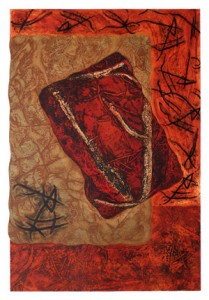 Natural Abstractions II © 2006. Linda C. Everson The last few days a horrible forest fire has been burning just west of Boulder in Fourmile Canyon. Forest, animals, homes, structures, and vehicles have been consumed by flames. It’s called one of the worst fire disasters in Colorado.
Wild fires in our state are always a potential issue, especially in the forested mountains, where they can spread so rapidly. A little wind, some dry conditions, a spark, and poof… up in flames. Often mother nature causes the problem (lighting). However, sometimes humans are the instigators, most often accidental, but other times because of carelessness (campfires, cigarettes, sparks). The devastation caused by the fires is awful, the regrowth of a forest takes countless years.
The monoprint Ode to the Forests II was done after the Hayman Fire in Colorado several years ago. It was started by a forest employee and 137,760 acres were consumed. Later, I rode my mountain bike on the Colorado Trail through some of the devastated areas. Nostalgia for the former forest inspired the series of monoprints.
|
|
 BINARY CODE: Binary is a two-digit numerical system in which computers store data and compute functions. Computers use the binary system because digital switches inside the computer can only be set to ON or OFF, which are represented by 1 or 0. In computer science, a code is considered as an algorithm which uniquely represents symbols from a source alphabet by encoded strings. ASCII uses a 7 bit binary code to represent text within a computer… 0100101 0111010
BINARY CODE: Binary is a two-digit numerical system in which computers store data and compute functions. Computers use the binary system because digital switches inside the computer can only be set to ON or OFF, which are represented by 1 or 0. In computer science, a code is considered as an algorithm which uniquely represents symbols from a source alphabet by encoded strings. ASCII uses a 7 bit binary code to represent text within a computer… 0100101 0111010![]() GENETIC CODE: The genetic code is based on sets of nucleoside base pairs called “codons”. Codons transcribe and translate genetic traits from DNA to RNA and RNA to proteins. New findings reveal that the human genome has 4 million + on/off switches that tell our genes what to do.
GENETIC CODE: The genetic code is based on sets of nucleoside base pairs called “codons”. Codons transcribe and translate genetic traits from DNA to RNA and RNA to proteins. New findings reveal that the human genome has 4 million + on/off switches that tell our genes what to do.![]() MORSE CODE: Morse Code transmits text by a series of on/off tones, lights, or clicks to commute a message.
MORSE CODE: Morse Code transmits text by a series of on/off tones, lights, or clicks to commute a message.![]() BRAILLE CODE: Braille is a binary encoding scheme that represents the characters of writing for the blind that is done in a series of 6 dots.
BRAILLE CODE: Braille is a binary encoding scheme that represents the characters of writing for the blind that is done in a series of 6 dots.
























